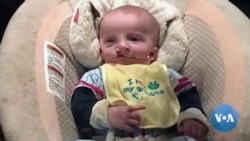ປາກແຫ່ວງຫຼືເພດານໂຫວ່ ແມ່ນເປັນການເກີດບໍ່ສົມປະກອບ ທີ່ເຫັນກັນຫຼາຍທີ່ສຸດ
ໃນທົ່ວໂລກ. ກ່ອນເກີດພວກທາລົກ ສາມາດມີປາກແຫ່ວງ ຫຼືເພດານປາກຂອງພວກ
ເຂົາເຈົ້າໂຫວ່ໄດ້. ປາກແຫ່ວງ ຕາມປົກະຕິແລ້ວແມ່ນຈະຕິດເຂົ້າກັນ ໃນສັບປະດາ
ທີ 6 ຫາ ສັບປະດາທີ 11 ຂອງການຖືພາ. ຖ້າມັນຫາກມັນບໍ່ເກີດຂຶ້ນແລະເດັກທາລົກ
ກໍແມ່ນຈະເກີດມາປາກແຫວ່ງ ແຕ່ພວກທ່ານໝໍສາມາດປົວໄດ້ ແຕ່ຖ້າຫາກວ່າ ການ
ເປັນປາກແຫວ່ງບໍ່ໄດ້ຮັບການປິ່ນປົວແລ້ວນັ້ນ ເດັກທາລົກສາມາດມີບັນຫາ ດ້ານສຸ
ຂະພາບທີ່ຮ້າຍແຮງໄດ້ແລະຈະມີຊີວິດສັ້ນ. ແຄໂຣ ເພຍຊັນ ນັກຂ່າວວີໂອເອມີລາຍ
ລະອຽດເພີ້ມຕື່ມ ຊຶ່ງວັນສະສອນ ຈະນຳມາສະເໜີທ່ານ ໃນອັນດັບຕໍ່ໄປ.
ໃນບັນດາປະເທດທີ່ຮັ່ງມີທັງຫຼາຍ ພວກທາລົກ ທີ່ເກີດມາເປັນໂຣກປາກແຫວ່ງ ຫຼື
ເພດານໂຫວ່ ຕາມປົກກະຕິແລ້ວແມ່ນຈະໄດ້ຮັບການປົວ ໃນທັນທີໂລດ.
ດຣ. ແອລເບີຣ໌ດ ໂອ (Albert Oh) ຝ່າຍສັນຍະກຳ ເດັກທາລົກ ກ່າວວ່າ “ທ່ານໝໍ
ທີ່ເຮັດວຽກຮ່ວມກັບຂ້າພະເຈົ້າ ແລະຂ້າພະເຈົ້າ ຄືພວກເຮົາທຳການຜ່າຕັດໂຣກ
ດັ່ງກ່າວ ສະເຫຼ່ຍແລ້ວ ກໍປະມານ 100 ກໍລະນີ ໃນແຕ່ລະປີ ຊຶ່ງມັນແມ່ນປະມານ
3 ຫາ 4 ກໍລະນີ ໃນນຶ່ງສັບປະດາ.”
ໃນສະຫະລັດ ມີເດັກທາລົກ 1 ໃນທຸກ 1,500 ຄົນໃດ ແມ່ນເກີດມາເປັນໂຣກເພດານໂຫວ່
ໃນຂະນະທີ່ 1 ໃນພວກທາລົກ 900 ຄົນໃດ ແມ່ນເກີດມາເປັນໂຣກປາກແຫວ່ງ. ເຜົ່າພັນ
ແມ່ນມີສ່ວນໃນເລື້ອງນີ້. ພວກເດັກທາລົກທີ່ສືບເຊື້ອສາຍມາຈາກອາຟຣິກາ ແມ່ນມີ
ຄວາມເປັນໄປໄດ້ຕ່ຳທີ່ສຸດ, ຄືປະມານ 1 ໃນ ທຸກໆ 1,200 ຄົນທີ່ເກີດມາ.
ດຣ. ແຢງ ຈາຍ ຈາກມະຫາວິທະຍາໄລພາກໃຕ້ລັດຄາລີຟໍເນຍ ກ່າວວ່າ “ແຕ່ ຖ້າຫາກ
ທ່ານເບິ່ງຈຳນວນພວກຜູ້ປ່ວຍໃນທົ່ວໂລກ, ຖ້າຫາກວ່າເຈົ້າແມ່ນຄົນເອ ເຊຍແລ້ວ
ຄວາມເປັນໄປໄດ້ ແມ່ນ 1 ໃນທຸກໆ 700 ຄົນ.”
ພວກເດັກທາລົກເຫຼົ່ານີ້ ແມ່ນໄດ້ເຮັດໃຫ້ເຂົາເຈົ້າກາຍເປັນຜູ້ທີ່ໜ້າສົງສານ ຍ້ອນພາບລັກ
ຂອງພວກເຂົາເຈົ້າ. ແຕ່ວ່າຄວາມສະລັບສັບຊ້ອນຈາກໂຣກປາກແຫ່ວງ ແລະເພດານໂຫວ່
ແມ່ນເກີນໄປກວ່າ ການຕົກແຕ່ງສັນຍາກຳ ພວກເຂົາເຈົ້າມີການປາກເວົ້າທີ່ຫຍຸ້ງຍາກ
ລຳບາກ ບັນຫາແຂ້ວນຳແລະອື່ນໆອີກຢ່າງຫຼວງຫຼາຍ. ເດັກນ້ອຍ ທີ່ເພດານໂຫວ່ນັ້ນ
ແມ່ນບໍ່ສາມາດດູດໄດ້. ການຂາດທາດອາຫານ ແມ່ນເກີດມີຕໍ່ພວກເດັກທາລົກທີ່ເພດານ
ໂຫວ່ ເຊັ່ນພວກເຂົາເຈົ້າເບິ່ງຄືວ່າ 3 ຫຼື 4 ປີ ອາດຈະແມ່ນ 8 ຫຼື 9 ປີກໍເປັນໄດ້.
ອົງການກຸສົນ ເຊັ່ນ ອົງການ Operation Smile ວາງແຜນຜ່າຕັດເພື່ອຊ່ອຍເຫຼືອພວກ
ທາລົກທີ່ເປັນໂຣກນີ້.
ດຣ. ບິລ ແມກກີ ຜູ້ກໍຕັ້ງອົງການ Operation Smile ກ່າວວ່າ “ຈົນມາຮອດປີ 1999
ພວກອາສາສະໝັກ ຊຶ່ງສ່ວນໃຫຍ່ແມ່ນມາຈາກສະຫະລັດ. ທຸກມື້ນີ້ ມີປະມານ 80
ເປີເຊັນ ຂອງພວກອາສາສະໝັກ ແມ່ນອອກມາຊ່ອຍເຫຼືອກັນ ຈາກ 70 ຫາ 80
ເປີເຊັນ ແມ່ນມາຈາກທົ່ວໂລກ. ສະນັ້ນ ປະມານ 70 ຫາ 80 ເປີເຊັນ ໃນການປະຕິ
ບັດງານຂອງພວກເຮົາແມ່ນປະກອບດ້ວຍຜູ້ຄົນໃນທ້ອງຖິ່ນ ໃນປະເທດຂອງພວກ
ເຂົາເຈົ້າ ທີ່ພວກເຮົາຝຶກສອນໃຫ້.”
ການສຶກສາອັນນຶ່ງສະແດງໃຫ້ເຫັນວ່າ ອົງການການກຸສົນທັງຫຼາຍ ແມ່ນຍັງສືບ ຕໍ່ທຳ
ການຜ່າຕັດ ຫຼາຍກວ່າ 80 ເປີເຊັນ ຂອງໂຣກປາກແຫ່ວງ ແລະເພດານໂຫວ່ ໃນຫວຽດ
ນາມ. ໃນບັນດາປະເທດທີ່ມີລາຍໄດ້ຕ່ຳ , ການປິ່ນປົວດ້ານສຸ ຂະນາໄມ ແມ່ນຈະຕ້ອງ
ໄດ້ຈ່າຍລ່ວງໜ້າກ່ອນການຮັກສາແລະຫຼາຍໆຄອບຄົວ ແມ່ນບໍ່ສາມາດທີ່ຈະຈ່າຍຄ່າ
ຜ່າຕັດນີ້ໄດ້.
ດຣ. ແມກກີ ກ່າວວ່າ ອົງການຈັດຕັ້ງຂອງທ່ານ ພວມພະຍາຍາມ ທີ່ຈະປ່ຽນແປງ
ເລື້ອງນີ້ຢູ່.
ດຣ.ແມກກີ ກ່າວວ່າ “ມັນໄດ້ໃຫ້ໂອກາດອັນດີງາມໃຫ້ພວກເຮົາເຂົ້າໃຈເຖິງພື້ນຖານ
ໂຄງລ່າງ ຂອງການຜ່າຕັດ ວ່າມີຄວາມສຳຄັນຍິ່ງ. ແລະການປັບປຸງພັດທະນາ
ເພື່ອສ້າງຄວາມກ້າວໜ້າໃຫ້ແກ່ພື້ນຖານໂຄງລ່າງໃນທົ່ວໂລກແບບໃດ.”
ໃນຂະນະທີ່ກຳມະພັນ ແມ່ນປະກອບເປັນປະມານ 30 ເປີເຊັນທີ່ພາໃຫ້ເພດານຂອງ
ປາກໂຫວ່ ແລະສຸຂະພາບຂອງແມ່ ກໍເປັນພາກສ່ວນທີ່ສຳຄັນຍິ່ງ, ພວກນັກວິທະຍາ
ສາດ ແມ່ນຍັງຊອກຄົ້ນຫາສາເຫດອື່ນໆ ດ້ວຍຄວາມຫວັງວ່າ ມື້ນຶ່ງ ຈະສາມາດປ້ອງ
ກັນ ບໍ່ໃຫ້ພວກເດັກນ້ອຍເປັນໂຣກປາກແຫວ່ງ ຫຼືເພດານໂຫວ່ໄດ້.
A cleft lip or cleft palate is one of the most common birth defects worldwide. Before birth, babies can have a split, or cleft, in their lip and the roof of the mouth. This split normally closes between the 6th to 11th week of pregnancy. If this doesn't happen, and the baby is born with this split, doctors can usually fix it. But if the cleft isn't fixed, the baby can have serious health problems and a shortened life. VOA's Carol Pearson has more on how this impacts children in low-income countries.
In rich countries, babies born with a cleft lips or palates are routinely taken care of.
Dr. Albert Oh, pediatric plastic surgeon
"My partner and I, we averaged over a hundred primary cases per year so that's about three or four a week."
In the U.S., about one out of every 1,500 babies is born with a cleft palate, while one out of every 900 babies is born with cleft lip. Race is a factor. Babies of African descent have the lowest possibility, about one out of every 1,200 births.
Dr. Yang Chai, University of Southern California
"But if you look at a patient population worldwide, if you are Asian, the prevalence is about 1 out of 700."
These children are often stigmatized because of the way they look. But complications from a cleft lip and cleft palate go beyond the cosmetic. They include difficulties with speech, dental problems and more. A baby with a cleft palate cannot suck. Malnutrition stunts children's growth so a child who looks like a three or four year old may be eight or nine.
Charities like Operation Smile organize surgical missions to help children with these conditions.
Dr. Bill Magee, founder, Operation Smile
"Up until about 1999, all of our volunteers pretty much came out of the United States. Today, 80 percent of our volunteers come out of 70 or 80 countries around the world." "so 70-80% of our missions are done by local people in their countries that we have trained."
One study shows that charitable organizations still perform more than 80 percent of cleft lip and cleft palate surgeries in Vietnam. In a number of low income countries, medical care has to be paid in advance, and many families cannot afford the cost of surgery.
Magee says his organization is trying to change that.
Dr. Bill Magee, founder, Operation Smile
It's given us this incredible opportunity to understand how the infrastructure of surgery is so important. 5:06 and how to advance that infrastructure in countries all over the world."
While genetic factors account for about 30 percent of cleft conditions, and the mother's health is a contributing factor, scientists are still searching for other causes with the hope of one day being able to prevent children from being born with cleft lips or palates.





